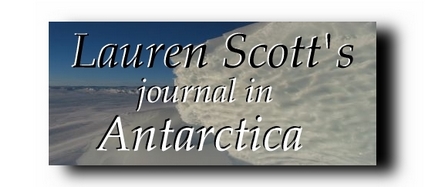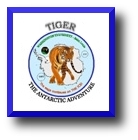|
TIGER in a steady state
Jason Link and Kurt Liewer arrived last
night and got out into the field with us today. Jason
is our "go-between" this year. He finished up his Ph.D. at
Washington University this past summer and got a post-doctoral position
at the University of Hawaii (the Principal Investigating University for
the
ANITA project) as soon as he was out. He actually used the data
that we gathered during our 2001 - 2002 campaign for his doctoral
thesis. So he was out helping the rest of the ANITA crew get
their instrument ready for flight.
TIGER continues to chug along and so far, there
don't seem to any "show stoppers" or problems that would keep TIGER
from operating properly during flight. My main focus these days
is continuing to work on some data analysis software so that we can
look quickly at TIGER data as it's coming down to make changes to the
instrument so that it is focusing on the right kind of particles that
we want to analyze. As I mentioned before, our data comes down
two different ways (by line-of-sight when it's nearby and by TDRSS
satellite when it's across the continent). Since our satellite
link has a relatively small data rate (about 6 kbits/sec) compared to
our line-of-sight (LOS) data rate (about 100 kbits/sec), the data is
packed differently when we are running in TDRSS mode. The main
difference is in the hodoscope
detectors.
In an ideal situation, a particle that penetrates
the TIGER instrument will only cause light to be emitted in one or two
hodoscope fibers. This will in turn cause the signals in only one
or two photomultiplier tubes to be much higher that the other
tubes. During LOS mode, all 192 photomultiplier tube levels are
sent down to us from the instrument. By being able to look at all
these tubes together, we can rule out an event where two or more
particles may have entered the detectors simultaneously. This may
happen when fibers light up that are far apart from one another along
the surface of the detector. In TDRSS mode, however, since we can
only send down the most vital information, Marty Olevitch, our
programmer has designed the system so that only 3 coarse and 5 fine
hodoscope tube levels are sent down. Furthermore, the program is
geared so that only photomultiplier levels from ultra-heavy cosmic rays
(which cause more light to be emitted in our detectors) are sent
down. In the event that we are unable to recover our hard drive
after the flight is over, we will have to make decisions about the
goodness of each event based on this somewhat limited data. So,
I'm working to make my software TDRSS friendly.
We decided this evening to let TIGER run
overnight. Since TRACER's TDRSS test has kept us from running
over the air, we are running TIGER directly tonight. Hopefully
I'll have some good data to play with tomorrow afternoon. I know,
I know, it doesn't seem like much fun, but I guarantee there's
something spine tingling about being able to look at the tracks of
whopper particle showers down here on the Ice!
And so back at McMurdo, it was the first crazy
Saturday night that I have gotten to see since I've been back.
There were a number of
parties, including the "Fiesta" party over in Hut 10 (looking at penguins way out on the ice from the
back porch at Hut 10), the "Skirt" party
down at Scott Base (the New Zealand station), the "White-Trash" party
over in dorm 210, and the "Skua" party up in the Skua building.
Now skua are these gigantic seagull-type birds
that are the most often seen kind of wildlife around here. It
also happens to be the name given to the McMurdo institution of
clothing trade. Since people buy things (boots, jackets, etc.)
specifically for use down here, they often don't want the extra weight
when they leave Antarctica to travel around. So, all over town
there are these large skua bins where you can leave your unnecesary
cargo behind or find some nice "new" clothes. This particular
party was held up at the skua building. I only had the energy to
make an appearance at two of them. The parties are truly amazing
and pretty wild - people of all ages and areas of expertise. And
then it was time for
bed. We are taking the day off tomorrow - a much needed rest.
|



